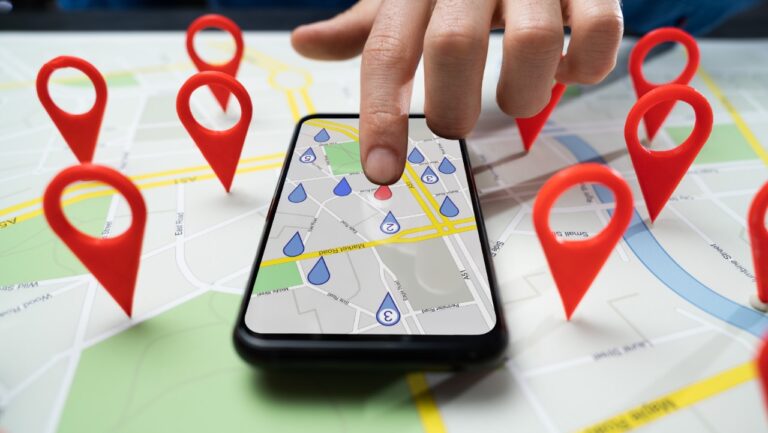Google Maps is a significant data source for businesses regarding enhancing visibility, optimizing marketing campaigns, and making data-driven strategic decisions for expansion and growth. It is not just a map but a goldmine of information to discover new locations and gain insights into the local market that can utilized for various purposes, including real estate market research, competitive analysis, and customer behavior analysis.
Extracting data from Google Maps can enable you to connect with a large number of B2B prospects, ranging from small to enterprise-level businesses. Leveraging this data effectively allows you to filter out businesses based on specific locations, industries, and other relevant criteria, enabling you to target your customers more precisely.
This article will explore how Google Maps data can help businesses grow, enhance customer experience, and expand their market share.
Harnessing Google Maps Data For Competitive Edge
As we discussed, Google Maps provides several benefits for businesses in gaining a competitive edge in the market:
- Enhanced Customer Experience – Integrating Google Maps Data into your application will provide information about nearby stores, their peak times, and customer reviews. This data helps customers decide the best place for their point of interest, enhancing their overall experience and simplifying virtual interactions with businesses.
- Improved Marketing Strategies – Google Maps Data can also help understand the geographical distribution of your target customers. This information allows you to run targeted marketing campaigns, tailoring messaging and promotions to specific regions for more effective outreach.
- Competitive Analysis – Extracting Google Maps data provides businesses with valuable insights into competitor locations and market presence. This allows you to estimate competitor density in different areas and identify locations that are not adequately covered or are underserved markets. With this information, businesses can make informed decisions about market expansion strategies.
- Geotargeting and Local SEO – By leveraging Google Maps data, businesses can optimize their SEO strategies and business listings, incorporate location-based keywords, and encourage customer reviews to increase their local search visibility and attract more foot traffic to their physical stores.
- Strategic Asset Management – For companies with multiple stores in a particular location or assets spread across different regions, Google Maps data can assist in managing these assets more effectively. By visualizing asset locations about customer demand, businesses can make strategic decisions about where to invest in upgrades, maintenance, or additional services.
How is Google Maps Data extracted?
The extraction of Google Maps data can be achieved through various methods, including:
- Using Google Maps API – Developers can integrate the official Google Maps API into their application to extract data from Google Maps, allowing access to a wide range of data points provided by Google, enabling developers to retrieve information like directions, geographic coordinates, addresses, and much more from Google Maps. However, it’s important to note that this API is not an economical choice compared to third-party services.
- Third-Party Tools And Services – Numerous third-party tools and services are available that provide custom scraping solutions for extracting data from Google Maps. These services offer various features and capabilities, including customizable parameters designed to retrieve results that meet specific criteria.
- Web Scraping – Web scraping techniques can be employed to scrape Google Maps data directly from their website. This process involves fetching the raw HTML data from the target URL using the preferred programming language for web scraping, with optimized headers, and refining the retrieved response using a parsing library to extract the desired information, such as ratings, reviews, and addresses of specific locations.
However, it’s important to note that Google Maps data can serve various purposes, including sentiment analysis, market research, and location-based services. Developers and users extracting data from Google Maps should adhere to Google’s Terms of Service to avoid any potential legal issues in the future.
Exploring Future Trends and Opportunities with Google Maps Data
As businesses increasingly prioritize an increasingly digital and data-driven landscape, the role of location intelligence provided by Google Maps data will become even more significant. In the future, several emerging market trends and opportunities will organize how businesses leverage this valuable data source for growth and innovation.
One key trend is the integration of augmented reality (AR) and virtual reality (VR) technologies with Google Maps data, enhancing user experience and greatly optimizing navigation capabilities. This opens up new possibilities for businesses in sectors such as retail, tourism, and real estate to provide interactive and personalized services to their customers.
Another promising avenue is the rise of predictive analytics and machine learning algorithms applied to Google Maps data, enabling businesses to predict consumer behavior, optimize operations, and deal with market trends with greater accuracy. This empowers businesses to stay ahead of the other competitors and make data-driven decisions based on collected insights.
Furthermore, the growing importance of sustainability and environmental consciousness presents opportunities for businesses to leverage Google Maps data for eco-friendly initiatives, such as optimizing delivery routes to reduce carbon emissions and promoting green transportation options.
Overall, as technology continues to evolve and businesses adapt to changing market dynamics, the future of Google Maps data holds immense potential for driving innovation, fostering growth, and shaping the way businesses interact with their customers and the world around them.
Wrapping Up
In a nutshell, Google Maps is a vital data source for businesses seeking growth. It assists in predicting market trends and gaining deep insights into customer sentiment, thereby enhancing the overall user experience. This allows tailored offerings to meet specific customer needs and preferences.
In this article, we learned the significance of Google Maps data for businesses. We also learned how this data is extracted and used to gain an edge in the market.
Thanks for reading!










